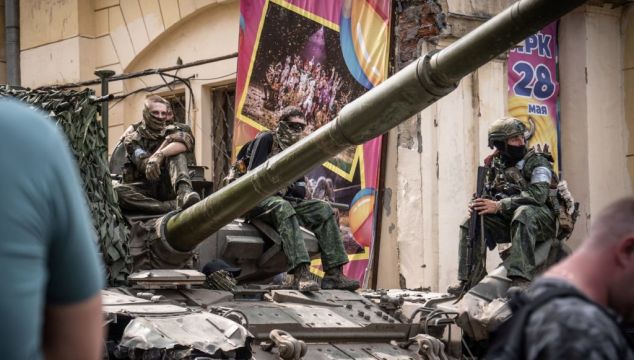As rebellious Wagner forces drove north toward Moscow on June 24th, a contingent of military vehicles diverted east on a highway in the direction of a fortified Russian army base that holds nuclear weapons, according to videos posted online and interviews with local residents.
Once the Wagner fighters reach more rural regions, the surveillance trail goes cold – about 100 km from the nuclear base, Voronezh-45. Reuters could not confirm what happened next, and Western officials have repeatedly said that Russia's nuclear stockpile was never in danger during the uprising, which ended quickly and mysteriously later that day.
But in an exclusive interview, Ukraine's head of military intelligence, Kyrylo Budanov, said that the Wagner fighters went far further. He said that they reached the nuclear base and that their intention was to acquire small Soviet-era nuclear devices in order to "raise the stakes" in their mutiny. "Because if you are prepared to fight until the last man standing, this is one of the facilities that significantly raises the stakes," Mr Budanov said.
The only barrier between the Wagner fighters and nuclear weapons, Mr Budanov said, were the doors to the nuclear storage facility. "The doors of the storage were closed and they didn't get into the technical section," he said.
Reuters was not able to independently determine if Wagner fighters made it to Voronezh-45. Mr Budanov did not provide evidence for his assertion and he declined to say what discussions, if any, had taken place with the United States and other allies about the incident. He also didn't say why the fighters subsequently withdrew.
Kremlin source
A source close to the Kremlin with military ties corroborated parts of Mr Budanov's account. A Wagner contingent "managed to get into a zone of special interest, as a result of which the Americans got agitated because nuclear munitions are stored there," this person said, without elaborating further.
A source in Russian occupied east Ukraine, with knowledge of the matter, said this caused concern in the Kremlin and provided impetus for a hastily negotiated end to the rebellion on the evening of June 24th, brokered by Belarusian president Alexander Lukashenko.
US officials expressed doubts about this account. In response to a query about whether Wagner forces reached the base and sought to acquire nuclear weapons, White House National Security Council spokesman Adam Hodge said, "We are not able to corroborate this report. We had no indication at any point that nuclear weapons or materials were at risk."
The Kremlin and Wagner commander Yevgeny Prigozhin did not respond to questions for this article.
Matt Korda, a Senior Research Associate and Project Manager for the Nuclear Information Project at the Federation of American Scientists, said it would be "virtually impossible for a non-state actor" to breach Russian nuclear security. Wagner may have had thousands of troops at its disposal, he said, but it's unlikely any of them knew how to detonate a bomb.
"If you had a malicious actor who was able to get their hands on a nuclear weapon, they would find the weapons stored in a state of incomplete assembly," he said. "They would need to be completed by installing specialised equipment and then unlocking permissive action links, and in order to do that they would need the cooperation of someone from the 12th Directorate" responsible for protecting Russia's nuclear arsenal.
Putin challenge
Mr Budanov is the first official to suggest Wagner fighters came close to acquiring nuclear weapons and further escalating an armed mutiny that has been widely interpreted as the biggest challenge to Russian president Vladimir Putin's power. US officials have long feared the nightmare possibility that strife in Russia might lead to nuclear devices falling into rogue hands.
Wagner fighters drove in the direction of Voronezh-45 after peeling away from a larger convoy of heavy weaponry that was advancing along the M4 highway that runs north from Rostov, where the rebellion began. This smaller group headed east, and engaged Russian forces in a firefight at the first village it reached, according to residents and social media posts. But then it appears to have passed without hindrance for 90 km, including driving unchallenged through the centre of a town that houses a military base.
Reuters followed the group's progress to the town of Talovaya, about 100 km from the base, which dates back to the Soviet era. It is one of Russia's 12 "national-level storage facilities" for nuclear weapons, according to a report by UN scientists. At Talovaya, Russian forces attacked the column, according to local people who spoke to Reuters. A Russian helicopter was shot down, killing the two crew.
Reuters interviewed Mr Budanov in his Kyiv office, which Russia targeted with strikes as recently as May. Dressed in military fatigues with a black pistol tucked into his waistband, Mr Budanov spoke in front of a painting that depicts an owl, a symbol of Ukraine's spy bureau, clutching a bat, symbol of Russia's military intelligence agency.
He said Voronezh-45 houses small nuclear devices that can be carried in a backpack. "This was one of the key storage facilities for these backpacks," he said, without providing evidence for this assertion. Reuters was unable to establish if the backpack-sized nuclear charges, referred to by Budanov, are kept at Voronezh-45.
Such small nuclear bombs – light enough to be carried by a single person – are Cold War relics. American troops trained to parachute from planes with nuclear weapons strapped to their bodies and Soviet troops trained to deploy them behind enemy lines on foot.
But by the early 1990s, both nations agreed to remove them from their arsenals as tensions eased, and did so, though Russia kept some to mine harbours, said Hans Kristensen, who leads the Nuclear Information Project at the Federation of American Scientists, based in Washington.
Several former US nuclear nonproliferation officials cautioned that it's difficult to know for sure whether the Russians kept their promise to destroy their backpack-style nuclear weapons. "I don't believe the Russians still have them, but I wouldn't bet my life on it," said David Jonas, former general counsel to the US National Nuclear Security Administration, which tracks atomic weapons and radioactive material worldwide.
Amy Woolf, a nuclear weapons specialist for US lawmakers at the Library of Congress from 1988 to 2022, raised doubts about the potency of such weapons if they do still exist. "It's possible there's still some old crap stuck in storage somewhere," she said. "But is it operational? Almost certainly not."
Mr Jonas, who advised top Pentagon officials on nonproliferation, agreed, noting that such portable weapons need to be maintained and updated, and degrade over time. He said Russia has struggled to maintain its conventional forces, let alone its atomic stockpile.
A falling out
Wagner was founded by Prigozhin and Dmitry Utkin, a former special forces officer in Russia's GRU military intelligence. Cast as a private army, Wagner enabled Russia to dabble in wars in countries including Syria, Libya and Mali with full deniability. US officials also say Prigozhin's business operated a social media troll factory that interfered with the 2016 American presidential election.
In recent days, Putin confirmed the Russian state financed Wagner. State television reported that Prigozhin's operations had received more than 1.7 trillion roubles (€17.4 billion) from the Russian budget.
Prigozhin fired the opening salvo of his mutiny on June 23rd when he accused the Russian military of launching a missile strike on a Wagner camp in Russian-occupied east Ukraine. Russia denied any such operation.
At least half a dozen sources inside and outside Russia say the conflict had been brewing for some time and that money and tensions between rival clans lay at its heart. For months, Prigozhin had been openly insulting Putin's most senior military men, casting defence minister Sergei Shoigu and chief of the general staff Valery Gerasimov as corrupt and incompetent and blaming them for reversals in Russia's war in Ukraine.
The insults went unanswered in public for a long time. Then Shoigu hit back. On June 10th, he ordered Wagner fighters to sign contracts with his ministry agreeing to become part of the regular army by month's end. Prigozhin refused. On June 13th, Putin publicly sided with Shoigu. The state was moving to cut Wagner's funding and this, the sources inside and outside Russia told Reuters, was the trigger for the mutiny.
In the early hours of June 24th, Wagner forces arrived in the southern city of Rostov, an important command centre for Russia's operations in Ukraine. Wagner took charge of the base there and within hours video emerged of Prigozhin chatting with Russian commanders. Around the same time, other contingents of Wagner forces struck out north, heading in the direction of Moscow along the M-4 highway.
Wagner fighters encountered little resistance.
Some Russian units that stood in their path or were instructed to intercept them did nothing, according to five sources: a Russian security source, three people close to the Kremlin, and a person close to the Russian-installed leadership in eastern Ukraine. The security source said two Russian military formations around the south-west of the country received orders to resist Wagner but they did not act on the command.

Some Russian units did nothing because they were taken by surprise and were outgunned, the sources said, while others stood by because they assumed, until Putin went on television at 10am. Moscow time to denounce Prigozhin, that Wagner was acting on the Kremlin's orders. The sources said some officers were reluctant to move against Wagner because they felt solidarity with the private army and shared Prigozhin's disillusionment with the way the defence ministry top brass was running the war.
At the Bugayevka crossing between Ukraine and Russia, images posted by a Wagner-affiliated Telegram channel on the morning of June 24th showed dozens of Russian troops standing in line, unarmed. The caption said they had laid down their weapons.
Oleksiy Danilov, Secretary of Ukraine's National Security and Defence Council, told Reuters that many in the Russian military sided with Prigozhin. "There are so many commanders who sympathise with Wagner and don't want to follow Putin," he said, adding that he knew of 14 Russian generals who supported Prigozhin. Reuters was not able to independently verify his account about the generals.
One branch of the Wagner force headed north along the M-4 highway, in the direction of Moscow. Their route took them right past Boguchar, a garrison town where a Russian unit is stationed. Three local residents who spoke to Reuters said that the military there did nothing to resist, and that a significant number of people in the town, including people serving in the military, felt sympathy with the Wagner force.
One woman said of Prigozhin: "Who else should we support? At least there's one dignified person who was not frightened." Another female resident also said Wagner had widespread support in the town, and that many Wagner fighters are from Boguchar. "They're all friends," she said.
A nuclear detour
As the main Wagner column advanced northwards towards Moscow, a group of military vehicles, and some civilian pickups and vans, turned eastwards. The moment is captured on a video posted on a Voronezh region news site. Reuters geo-located the video to a junction near the town of Pavlovsk. The breakaway contingent rumbled through villages and along a road that cut through patches of forest and flat farmland, skirting gulleys carved out by tributaries of the Don River.
A video posted on a local online bulletin board shows a field in the dawn light near the village of Elizavetovka on June 24th. In the distance there is an explosion and gunfire, and panicked cries from a male voice: "Has a war started?"
Then a fresh round of automatic gunfire, closer this time.
Reuters spoke to the man's neighbour, who said the Russian military had attacked the Wagner force. At 8.24am, a user on the same online bulletin board, Anna Sandrakova, wrote: "Shells are flying, low-flying helicopters, we could hear explosions, automatic gunfire." Maxim Yantsov, the local government chief for Pavlovsk district, wrote on his Telegram channel that 19 households were damaged as a result of shooting around Elizavetovka.
A few hours later, the convoy passed through another village, Vorontsovka, still moving in the direction of the nuclear facility. Two videos posted to Telegram show more than a dozen vehicles, including armoured personnel carriers, tanks and trucks mounted with machine guns or carrying artillery.
Next on the route, the convoy reached Buturlinovka, according to posts on the town's online bulletin board and a video that Reuters identified as being recorded in the town. Buturlinovka, closer still to the nuclear facility, is the location of a military air base.
By Saturday evening, users on a VKontakte online forum started reporting the presence of a military column at the town of Talovaya, 110km from the military base.
A video shared by a local resident with Reuters shows a column of military vehicles moving through the outskirts of the town. A second video, provided by another resident, showed at least 75 vehicles in a convoy on the edge of the town, including five armoured personnel carriers, two ambulances, and an artillery gun towed behind a truck.
A third resident said local people offered food and water to the Wagner troops. The situation was calm, he said, until a Russian helicopter fired at the column. It fired back and the helicopter fell to the ground, followed by explosions and a cloud of smoke.
Russian state media later broadcast video of a wooden cross erected at the site in Talovaya district where the helicopter, a Ka-52 attack aircraft, crashed. Pskov region governor Mikhail Vedernikov said the two crewmen who were killed were stationed at a military base in his region, in north-west Russia. "True to their oath, they did everything to protect our country," he said in a video address posted on his Telegram channel.
Reuters couldn't determine what the column did next. A resident of Talovaya said that as far as he was aware, it did not move any further and the following day – after the truce was announced – the column turned around and went back the way it came.
Mr Budanov said in his interview that an unspecified number of fighters did in fact press on to Voronezh-45 with the intention of seizing portable, Soviet-era nuclear weapons stored at the facility.
The nuclear facility at Voronezh-45 is operated and guarded by military unit no. 14254, part of the defence ministry's 12th Main Directorate responsible for protecting Russia's arsenal of nuclear weapons, according to the Russian defence ministry's website and publicly available records. What is stored there is a closely guarded secret. Russia does not publicly acknowledge even keeping nuclear weapons there; that information has emerged from the reports of foreign scientists.
Reuters was unable to establish if the backpack-sized nuclear charges referred to by Budanov are kept at the facility. But there is evidence that such devices were developed by the Soviet Union. In testimony to the US Congress, in 1997 Alexei Yablokov, a former Russian presidential science advisor, said Soviet scientists in the 1970s created suitcase-sized nuclear munitions for use by secret agents.
Kristensen, the Federation of American Scientists researcher who said that Russia and the United States discarded thousands of suitcase-sized nukes in the 1990s, said that he doubts any remain stored Voronezh-45. He said he believes – but cannot be certain – that other nuclear weapons are stored at Voronezh-45, which satellite images show to be well-maintained.
Given the 12th Main Directorate's control over the facility, the movement of weapons would take time and likely be detected by US satellites, he added.
Further north, there is evidence that the Russian military undertook drastic measures to block off another potential access route to Voronezh-45. The E-38 road branches off the M-4 highway at a settlement called Rogachevka. This road also leads to Voronezh-45. On the evening of June 24th, local residents reported hearing explosions.
A video posted on a Telegram channel captured the sound of an aircraft followed by an explosion. A motorist driving along the E-38 posted a video that shows the road covered in debris near a bridge over the river Bityug. In one lane is a deep crater.
A deal is struck
On the evening of June 24th there was an unexpected announcement by Belarusian state media. The country's president, Alexsandr Lukashenko, had negotiated Prigozhin's agreement to halt his forces' advances. Prigozhin said in an audio message that his forces had come within 125 miles of Moscow and were "turning around" to head back to their training camps. Under the deal, Russia would not prosecute the rebels and Wagner fighters would either withdraw to Belarus or join Russia's regular army.
A European intelligence source said Prigozhin was persuaded to abandon his revolt after realising he didn't have sufficient support amongst the military.
Prigozhin's whereabouts and future plans are unclear.
Kremlin spokesman Dmitry Peskov said on Monday that Putin held talks with the Wagner leader on June 29th and "gave his assessment of the events" of June 24th.
One of Prigozhin's private jets has made multiple trips between Belarus and Russia in the days since the rebellion, according to flight tracking data.
When Belarusian president Lukashenko hosted a group of journalists in Minsk on July 6th, he said Wagner's fighters had yet to arrive at their new Belarusian base. "As for Yevgeny Prigozhin, he's in St Petersburg. Or perhaps this morning he flew to Moscow. Or perhaps he's somewhere else. But he's not in Belarus," Lukashenko said.







